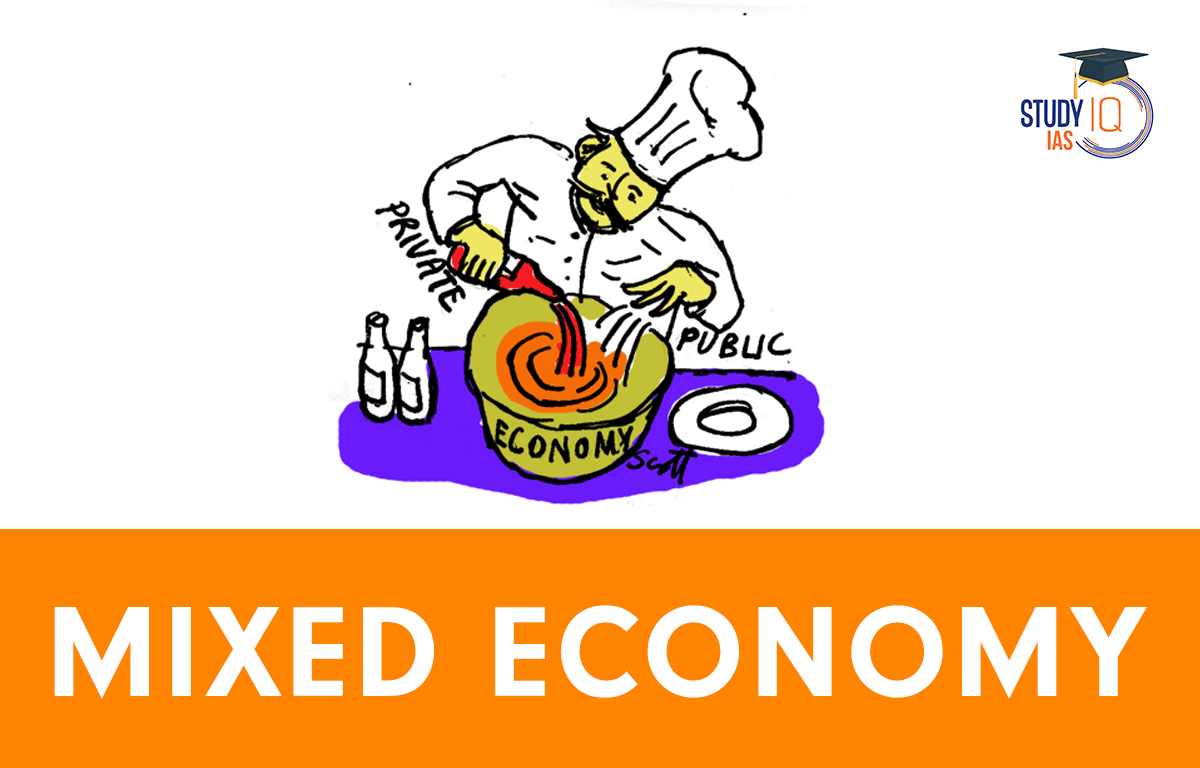Table of Contents
Mixed Economy
A mixed economy is an economic system that combines elements of both a free market economy and a command economy. In a mixed economy, the government and private sector both play important roles in economic decision-making.
In a mixed economy, the government regulates certain industries and provides public goods and services such as education, healthcare, and infrastructure. At the same time, private individuals and businesses are allowed to own property, make profits, and engage in market transactions.
Read about: India’s GDP Growth Rate
Mixed Economy Features
Some of the key features of a Mixed Economy include:
| S. No | Feature | Description |
| 1. | Private Property | Individuals and businesses are allowed to own property and assets and to make decisions about how to use them. |
| 2. | Free Market | Markets are allowed to operate relatively freely, with supply and demand determining prices and quantities. |
| 3. | Government Regulation | The government regulates certain industries and economic activities to ensure fair competition, protect consumers, and promote public welfare. |
| 4. | Public Goods and Services | The government provides certain public goods and services, such as education, healthcare, and infrastructure, that are considered essential for the common good but might not be profitable for private businesses to provide. |
| 5. | Taxation and Redistribution | The government uses taxation and other policies to redistribute wealth and income, reduce inequality, and promote social welfare. |
| 6. | Mixed Ownership | Some industries and businesses are owned and operated by the government, while others are privately owned and operated. |
| 7. | Economic Planning | The government may engage in some level of economic planning to guide investment and development in certain sectors, although this is typically less extensive than in a command economy. |
| 8. | Entrepreneurship | Private individuals and businesses are allowed to innovate, take risks, and create new products, services, and industries. |
Read about: Capitalist Economy
Mixed Economy in India
India is often cited as an example of a mixed economy, where both the government and private sector play important roles in economic decision-making.
In India, the government has historically had a significant presence in the economy, with state-owned enterprises and public sector undertakings operating in a wide range of industries, including transportation, energy, and telecommunications. The government has also been involved in economic planning, with a focus on promoting social welfare and reducing inequality.
At the same time, India has also undergone significant economic liberalization in recent decades, with a move towards more market-oriented policies and an emphasis on private sector development. This has included measures such as deregulation, privatization, and foreign investment liberalization.
Today, the Indian economy is characterized by a mix of public and private ownership, with both domestic and foreign companies operating in a wide range of sectors. The government still plays a significant role in certain industries, such as banking and insurance, and provides public goods and services such as education and healthcare
Read about: Macroeconomics and Microeconomics
Mixed Economy Examples
There are many examples of countries with mixed economies, where both the government and the private sector play important roles in economic decision-making. Here are some examples:
- Canada is often cited as a classic example of a mixed economy, with a mix of private and public ownership in various industries, significant government intervention in certain sectors such as healthcare and education, and a commitment to social welfare programs.
- Germany is known for its social market economy, which combines a strong emphasis on private enterprise and market competition with government regulation and support for social welfare programs such as healthcare and pensions.
- Japan has a highly developed mixed economy, with a strong emphasis on private enterprise and innovation, significant government intervention in certain industries such as transportation and energy, and a commitment to social welfare programs.
- Sweden is often cited as a model for the Nordic model of social democracy, which combines a strong welfare state with a highly competitive private sector and an emphasis on innovation and entrepreneurship.
- The United Kingdom has a mixed economy that combines elements of both capitalism and socialism. The government plays an important role in providing public goods and services such as healthcare and education, while also encouraging private enterprise and market competition.
Read about: GDP of Indian States
Mixed Economy Merits
Mixed economies have several strengths, which make them a popular economic model around the world. Some of the key strengths of mixed economies include:
- Flexibility: Mixed economies allow for a high degree of flexibility, as they combine the advantages of both private enterprise and government intervention. This enables them to respond effectively to changing economic conditions and social needs.
- Innovation: Mixed economies can promote innovation and entrepreneurship, as they provide a supportive environment for private enterprise and competition, while also investing in public goods and services that support innovation and growth.
- Stability: Mixed economies can provide a stable economic environment, as they combine market mechanisms with government intervention to mitigate the risks and uncertainties of the business cycle.
- Social Welfare: Mixed economies can provide a high level of social welfare, as they combine market mechanisms with government programs to ensure that basic needs are met for all members of society.
- Balanced Growth: Mixed economies can promote balanced economic growth, as they combine private enterprise with government intervention to ensure that growth is sustainable and equitable and that benefits are shared widely across society.
Mixed Economy Demerits
While mixed economies have several strengths, they also face several challenges. Some of the key challenges of mixed economies include:
- Balancing Private Enterprise and Government Intervention: One of the biggest challenges of mixed economies is striking the right balance between private enterprise and government intervention. Too much government intervention can stifle private enterprise and innovation, while too little intervention can lead to market failures and inequality.
- Political Pressure: Mixed economies are subject to political pressures, as government policies are often influenced by political considerations rather than purely economic ones. This can lead to inefficiencies and distortions in the economy.
- Coordination: Mixed economies require effective coordination between government agencies, private enterprises, and other stakeholders to ensure that economic policies and programs are implemented effectively. This can be challenging, particularly in large and complex economies.
- Bureaucracy: Government intervention in mixed economies can lead to bureaucratic inefficiencies, as government agencies may become overly complex and bureaucratic in their operations.
- Fiscal Sustainability: Mixed economies require significant public investment in infrastructure, social welfare programs, and other public goods and services. This can lead to fiscal challenges, particularly if public spending is not matched by tax revenues.
Read about: Unemployment Rate in India
Difference Between Capitalist, Socialist and Mixed Economy
Some of the key points of difference include:
| S. No | Aspect | Capitalist Economy | Socialist Economy | Mixed Economy |
| 1. | Ownership of means of production | Privately owned | Publicly owned | Mix of private and public ownership |
| 2. | Role of market forces | Central | Minimal | Important |
| 3. | Role of government | Limited | Extensive | Regulates and provides public goods/services |
| 4. | Economic inequality | High | Low | Moderate |
| 5. | Competition | Encouraged | Discouraged | Encouraged with regulation |
| 6. | Social services | Private or none | Provided by the state | Provided by both private and public sectors |
| 7. | Economic planning | Limited | Extensive | Limited, focused on specific areas |
| 8. | Examples | United States | Cuba, North Korea | Canada, Japan, Germany |
Read about: Socialist Economy
Mixed Economy UPSC
Mixed Economy is an important topic for the UPSC exam as it is included in the UPSC Syllabus for both the Preliminary and Mains exams under the Economics section. Understanding the features, strengths, and challenges of mixed economies is essential for aspirants preparing for the UPSC exam. StudyIQ UPSC Online Coaching and UPSC Mock Test cover this topic comprehensively, which can help aspirants to prepare for the exam effectively.
Read about: Unemployment Rate in India


 Repo Rate and Reverse Repo Rate, Impact ...
Repo Rate and Reverse Repo Rate, Impact ...
 Foreign Contribution Regulation Act (FCR...
Foreign Contribution Regulation Act (FCR...
 Urban Cooperative Banks in India, Functi...
Urban Cooperative Banks in India, Functi...





















